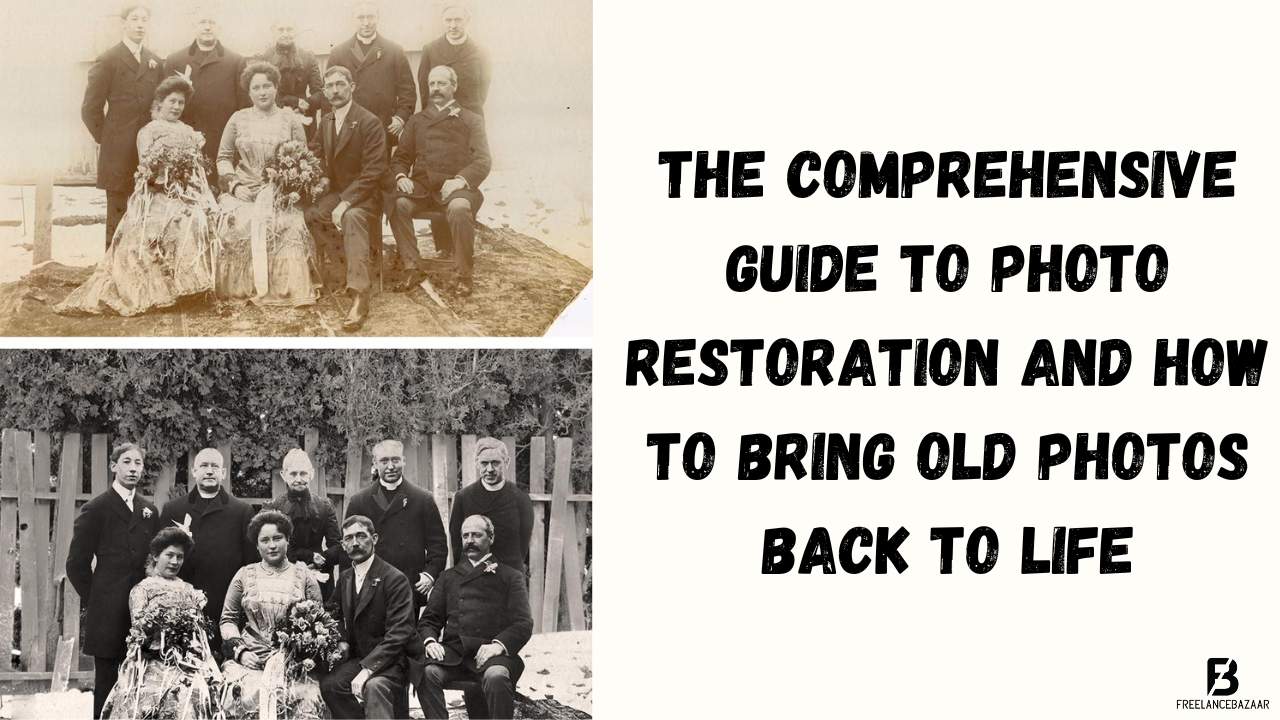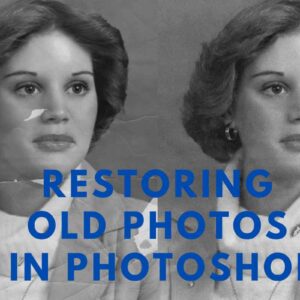Old photos are a precious reminder of the past. But with time, they can become faded and damaged. Photo restoration specialists bring new life to old photographs. They uncover lost and faded colors, bring out fine details, and restore portraits to their original condition. This comprehensive guide will walk you through the process of photo restoration and help you bring your old photos back to life.
In this guide, we'll look at how to identify which photos need restoration, how to assess the damage, and what tools and techniques are used in the photo restoration process. We'll also discuss different use cases for photo restoration such as restoring family heirlooms or preserving historical artifacts. Finally, we'll discuss the importance of finding a professional photographer who specializes in photo restoration for more complex projects.
What is Photo Restoration and How Does it Work?
Photo Restoration is a professional process that returns old, faded, and damaged photos to life. Whether you want to restore a single photo or an entire collection, our state-of-the-art restoration tool has the ability to bring them back from the dead. Post Restoration offers photo restoration services to photo collectors, artists, and others. We put your damaged old photos back into shape, and make them look like they're brand new. The end result is a restored photo that looks as good as new.
Photo restoration can be done manually or with the help of specialized software and tools. Manual photo restoration requires a great deal of skill and experience, while digital photo repair tools can make the process faster and easier.
Whether you’re looking to restore old family photos or you need to repair digital photos for professional use, understanding how photo restoration works can help you get better results.
The restoration process usually requires the following steps:
- Scanning the original photograph to create a digital copy that can be worked on using digital software.
- Identifying areas that need to be repaired, such as scratches, stains, or missing parts of the image.
- Using digital tools to repair the damaged areas. This can involve techniques such as cloning, where a damaged area is copied from another part of the image and used to replace the damaged area, or using the brush tool to paint over the damaged area.
- Adjusting the brightness, contrast, and color balance to improve the overall appearance of the image.
- Saving the restored image as a digital file, which can be printed or shared online.
The process of photo restoration requires a combination of technical skill and creativity to achieve the desired result. Professional photo restoration services are available for those who want to restore their old or damaged photos but lack the expertise or software to do it themselves.
Common Mistakes to Avoid When Restoring Old Photographs
Restoring old photographs can be a challenging task. It requires careful attention to detail and a deep understanding of the medium. However, there are some common mistakes that people make when restoring old photos that can lead to unsatisfactory results. In this article, we will discuss some of the most common errors that people make when restoring old photographs and how to avoid them. We will also discuss tips on how to successfully restore an old photograph without making any mistakes. By following these tips, you can ensure that your restoration project will be successful and the results will be satisfactory.
Here are some common mistakes to avoid when restoring old photographs:
- Overdoing the restoration: It can be tempting to try to fix every little imperfection in an old photo, but it's important to be careful not to overdo it. Over-restoration can lead to a loss of detail and make the photo look artificial.
- Not keeping a backup: You should always have a backup of the original image in case you need to revert to the original.
- Not working on a copy: When restoring an old photo, it's important to work on a copy of the scanned image rather than the original. This way, you can make changes and experiment without risking damage to the original.
- Using the wrong tools: Different restoration tools are suitable for different types of damage. Using the wrong tool or technique can lead to further damage to the photo.
- Not understanding color balance: When restoring an old color photograph, it's important to understand color balance and how it can be affected by the aging process. Failing to account for color balance can result in inaccurate or unrealistic colors in the restored photo.
- Not understanding the historical context: When restoring an old photograph, it's important to understand the historical context in which it was taken. This can help you make informed decisions about how to restore the photo and ensure that it remains true to its original character.
Understanding the Different Types of Photo Restoration Tools and Techniques
Photo restoration is an important part of preserving memories. Over time, photos can become damaged due to age, water damage, or other factors. Fortunately, there are a variety of photo restoration tools and techniques available to help restore photos to their former glory. These tools range from simple photo editing software to more advanced programs that specialize in retouching and restoring photographs. In this article, we will discuss the different types of photo restoration tools and techniques so you can choose the best one for your needs.
Here are some of the different types of photo restoration tools and techniques:
- Image Editing Software: Image editing software, such as Adobe Photoshop or GIMP, is essential for photo restoration. These programs allow you to adjust brightness, contrast, sharpness, and color balance, as well as clone or heal damaged areas.
- Cloning: Cloning is a technique used to replace damaged areas of a photo with an undamaged area from elsewhere in the same photo. This technique can be used to fill in missing parts of the image, such as a torn corner or a scratched surface.
- Healing: Healing is a technique used to blend damaged areas with surrounding pixels to make the damage less visible. This technique is often used for small scratches, blemishes, or stains.
- Color Correction: Color correction involves adjusting the colors in a photo to correct for fading, discoloration, or incorrect color balance. This technique can help restore the original colors of the photo.
- Sharpening: Sharpening is a technique used to improve the overall sharpness of a photo. This technique can be used to bring out details and make the image look more crisp and clear.
- Tone Matching: Tone matching involves adjusting the brightness and contrast of different areas of a photo to match the tone of the surrounding areas. This technique can help make the photo look more natural and realistic.
- Colorization: Colorization is a technique used to add color to black-and-white photos. This technique involves manually adding color to the photo based on historical references or artistic choices.
Overall, successful photo restoration requires a combination of technical skill, artistic vision, and a deep understanding of the tools and techniques involved.
What are the Benefits of Using a Professional Photo Restoration Service?
Using a professional photo restoration service has many benefits. You can save time and money by having a professional take care of the job instead of doing it yourself. Additionally, you will get the best results possible with the help of AI-assisted techniques that are used in modern photo restoration services.
Using a professional photo restoration service can provide a number of benefits, including:
- Expertise and experience: Professional restoration services have the expertise and experience to restore photos to a high standard. They have knowledge of various restoration techniques and tools and can apply them effectively to restore old and damaged photographs.
- Access to specialized software and equipment: Professional restoration services have access to specialized software and equipment that is specifically designed for photo restoration. This equipment can provide higher-resolution scans and better restoration results than consumer-grade equipment.
- Time savings: Restoring a photo can be a time-consuming process, especially if you're not experienced with photo restoration. A professional service can save you time and effort by taking care of the restoration for you.
- Preservation of the original: Professional restoration services understand the importance of preserving the original photograph. They work with the digital copy of the photo, rather than the original, to ensure that the original is not further damaged.
- Restoring sentimental value: Old and damaged photographs often hold sentimental value, and restoring them can bring back cherished memories. A professional restoration service can help restore the photo to its former glory and preserve it for future generations.
Overall, using a professional photo restoration service can provide peace of mind that your treasured memories are being restored to a high standard by experts who understand the importance of preserving the original.
Conclusion:
Photo restoration services are an essential part of preserving memories and moments. With the help of professional photo restoration services, you can now keep your photos looking like new for years to come. Professional photo restoration services have the necessary tools and expertise to bring back even the most severely damaged photos to their original condition. They can also help you preserve your family’s history by restoring old photos that have been damaged by time or other factors. With a professional photo restoration service, you can make sure that your precious memories will last for generations.



